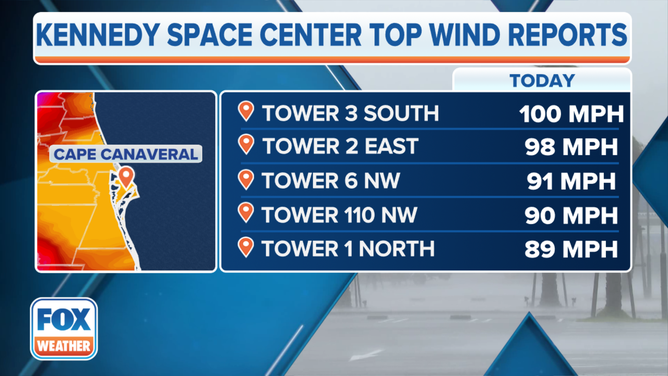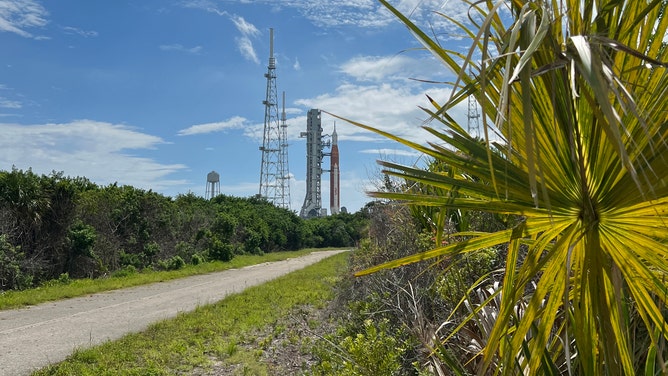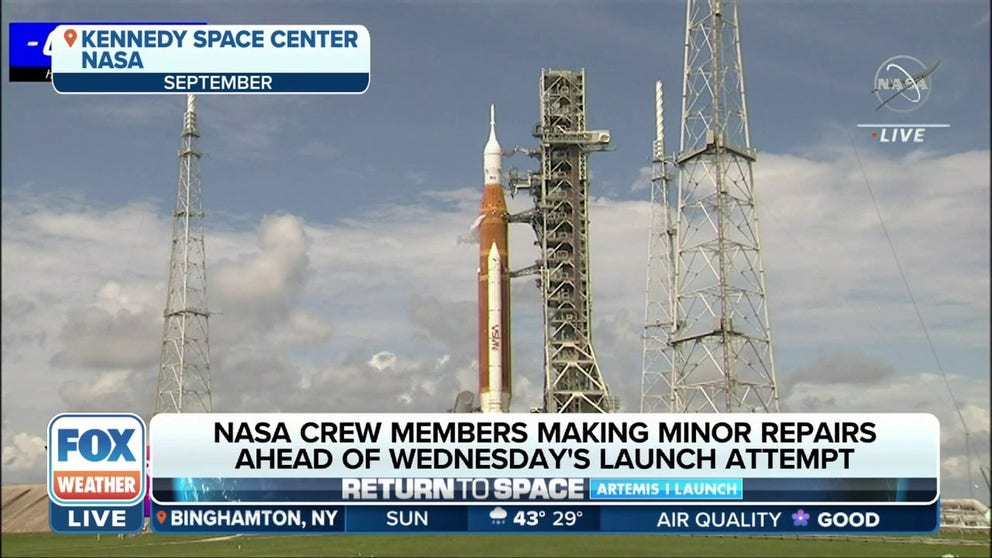NASA: Artemis rocket needs minor repairs after Hurricane Nicole before Nov. 16 launch
Despite wind measurements available through the NWS showing gusts up to 100 mph, NASA said none of the measured gusts exceeded the SLS certification limits. NASA will move ahead with the launch attempt on Nov. 16 at 1:04 a.m.
Why NASA left $4 billion Artemis rocket on the launch pad during Hurricane Nicole
FOX Weather space specialist Emilee Speck explains why NASA left its $4 billion Artemis rocket on the launch pad as Hurricane Nicole barreled toward Florida’s Space Coast last week.
NASA's mega moon rocket, the Space Launch System, suffered minor damages from Hurricane Nicole that can be repaired ahead of launch on Wednesday.
Nicole made landfall Thursday as a Category 1 hurricane with 75-mph winds near Vero Beach, about 70 miles south of Kennedy Space Center, where the $4 billion SLS and Orion spacecraft stood on the launchpad.
NASA is targeting Nov. 16 at 1:04 a.m. for the third attempt to launch the uncrewed Orion around the moon and back for the Artemis 1 test flight.
The space agency decided earlier this week to leave the 322-foot-tall rocket at Kennedy Space Center launchpad 39B, where it has been since the rollout on Nov. 4.
In hindsight, NASA’s Associate Administrator for Exploration Systems Development Jim Free said if the agency knew before rollout Nicole would strengthen to a hurricane, they would have left the rocket in the Vehicle Assembly Building. Still, ahead of rollout with the current forecast for Nicole – which was still a subtropical storm at that point – there were no dissenting opinions to moving the rocket to the launchpad.
"We also design it to be out there. And if we didn't design it to be out there in harsh weather, we picked the wrong launch spot, and we should have designed the vehicle better," he said.
During Nicole, observations were taken at 55 feet, 132 feet and up to 457 feet at the launchpad. Each height has a different certification wind limit.

Top wind reports at Kennedy Space Center launchpad 39B recorded from Hurricane Nicole.
(FOX Weather)
Despite wind measurements available through the National Weather Service showing gusts up to 100 mph, Free said the anemometers measured gusts that did not exceed the SLS's wind limits.
"During the event, the hurricane, all the measurements taken showed no breaking of those limits," Free said. "So the loads are going to vary at each of those heights and the peak we can take at each of those heights. None of those were exceeded for our certification limits."
According to NASA, the SLS can remain at the launchpad with peak winds up to 74.1 knots (85 mph) at 60 feet up. Free said that limit still has a 25% margin, meaning the rocket can withstand stronger winds.
Storm cleanup work begins before launch

NASA's SLS and Orion spacecraft at Kennedy Space Center in Florida ahead of the Aug. 29, 2022 launch. (Image: NASA)
On Friday, NASA teams will power up the rocket systems to ensure everything is functioning.
Free listed off several minor repairs and maintenance items that need to happen because of Nicole.
Some caulking around the Orion spacecraft came loose during Nicole and will need to be "snipped off," according to Free. The sealant used near Orion's launch abort system can be reached by the crew access arm.
Some water made it inside the crew access arm and will be mopped up.
A crew also went up the launch tower to place an umbilical to the Orion spacecraft back in the supporting tray. Free said this involved a person climbing out more than 300 feet up to straighten out the umbilical.
WHAT IS NASA'S ARTEMIS 1 MISSION GOING TO DO?
"You can imagine the height there," he said.
Free said nothing is preventing NASA from moving ahead with the Wednesday launch. The countdown will begin on Tuesday when the SLS is fueled with more than 700,000 gallons of cryogenic propellant.
According to Free, the decision to launch is being made the same way as it would if astronauts were onboard Orion for this flight.
"People care and about the quality of their work regardless," Free said. "We'll always look at things hard when we put humans on there, but from our perspective, from requirements, we were within the requirements limits, and the strength of this vehicle and the strength of the design of this vehicle is the same as the strength of the design of Artemis II."
Artemis II will be the first launch with astronauts on Orion, which will also orbit the moon.
Should Wednesday's launch not happen, the backup launch window opens on Nov. 19 at 1:45 a.m.
NASA also received permission from the Federal Aviation Administration for a launch opportunity on Nov. 25, Black Friday.
